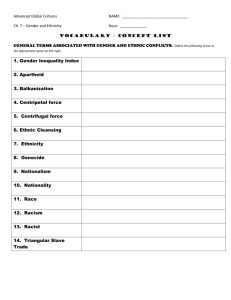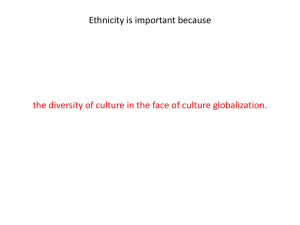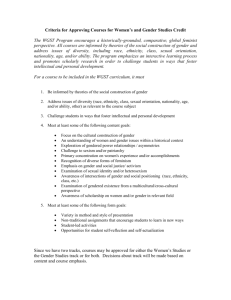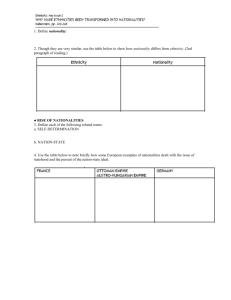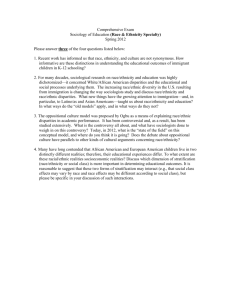Ethnicity, Race, and Nationality
advertisement
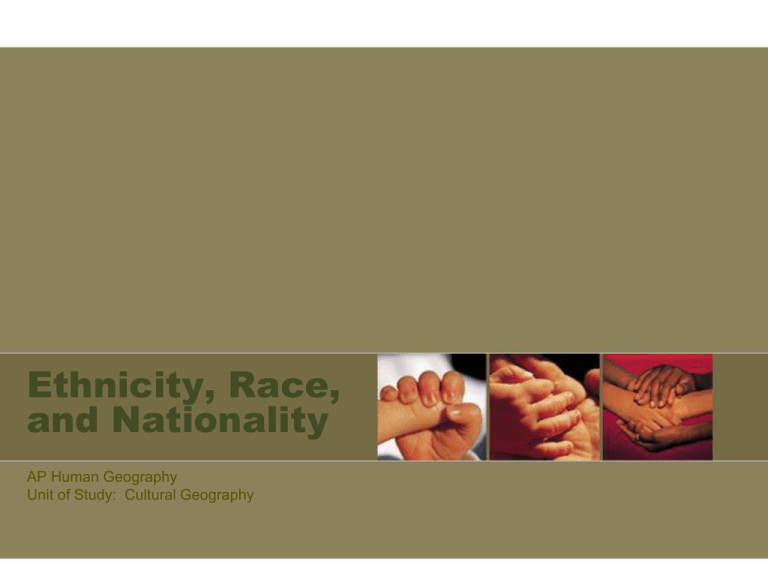
Ethnicity, Race, and Nationality AP Human Geography Unit of Study: Cultural Geography Overview • Ethnicity is growing in importance as people all over the world embrace their cultural heritage. • Personal and group identities are important and ethnicity is likely to remain diverse even with the globalization of religions, languages, economics, and politics. What is ethnicity? • Ethnicity is identity with a group of people who share the cultural traditions of a particular homeland or hearth. • Ethnicity comes from the Greek word ethnikos, which means national. Importance of Ethnicity to Geographers • Where? Like other characteristics of culture, geographers are interested in where ethnicities are distributed. • An ethnic group is tied to a particular place, because members of the group—or their ancestors—were born and raised there. The cultural traits displayed by an ethnicity derive from a group’s homeland. Importance of Ethnicity to Geographers • Why care? Ethnic identity comes from the interplay of migration and isolation from other groups. • Why ethnicities are distinct comes from their interaction with and isolation from other groups. Importance of Ethnicity to Geographers • Globalization. Although there are ethnic groups that fight to gain control of territory, NO ethnicity is attempting or even aspiring to achieve global dominance. • Even if globalization engulfs language, religion, or other cultural elements, the diversity of ethnic identity will remain. Assimilation v. Acculturation • Assimilation: the process of responding to new situations in conformity; “blending” in • Acculturation: the process by which a human being acquires the culture of a particular society African Americans in the U.S. Hispanic Americans in the U.S. Asian Americans in the U.S. Native Americans in the U.S. Ethnicities in Africa: First…a look at the political map! Ethnicities in Africa What is race? • Race is identity with a group who share a biological ancestor and it is distinct from ethnicity. • Example: In the U.S., Asians are a race and Asian Americans encompass basically the same ethnic group of people, though Asian American is a broad grouping for people from diverse Asian backgrounds. Important Term • Racism: the belief that race is the primary determinant of human traits and capacities and those racial differences produce an inherent superiority of a particular race. What is nationality? • A nationality is identity with a group of people who share legal attachment and personal allegiance to a particular country. • A nation or nationality is a group of people tied together to a particular place through legal status and cultural traditions. Differences… • Ethnicity describes cultural identity while nationality describes political ties and ideas about voting, passports, and civic duties. • American is a nationality, Hispanic-American or African-American are ethnicities, and race is the genetic heritage with skin color being the most visible trait. Self-identification • What is it? the act of identifying yourself as a particular kind of person, including your ethnicity and race Nationalism • Nationalism is loyalty and devotion to a nationality. • Nationalism promotes one nationality and culture above that of other nations. How is nationalism fostered? • Mass media (controlled in some states— believed to be a risk to the government) • Flags, songs, symbols, holidays • Propaganda (often negative images about other countries) Samples of symbols or images that promote nationalism Sample of propaganda intended to promote a particular attitude about war Centripetal and Centrifugal Forces • A centripetal force is an attitude that tends to UNIFY OR CONNECT people and enhance support for a state (country). • A centrifugal force is an attitude that tends to DIVIDE people and decrease support for a state. Do you know the difference? Centripetal or centrifugal? 1. flag 2. civil war 3. interstate system 4. national anthem 5. poor economy The Index of Residential Dissimilarity —What is it? • Segregation is a shorthand expression for the extent to which members of an ethnic group are not uniformly distributed in relation to the rest of the population. • Think of separation! The Index of Residential Dissimilarity —What is it? • A commonly employed measure for quantifying the degree to which a distinctive group is segregated is the index of residential dissimilarity. • It indicates the difference between the distributions of two component groups of a population, with a theoretical range of values from 0 (no segregation) to 100 (complete segregation). The Index of Residential Dissimilarity —What is it? • Example: Detroit, Michigan – 1. Population (2011): 9.8 million people – 2. Overall segregation index—83 (established by the U.S. Census Bureau) – 3. Index of Dissimilarity: • Blacks: 89 • Hispanic: 42 • Asian: 48 The Index of Residential Dissimilarity —What is it? • Evidence from cities throughout the world makes it clear that most ethnic minorities tend to be sharply segregated from the charter group. • Charter means “first,” referring to the first group that has a lasting impact on the cultural landscape. To what extent is America a “melting pot”? Well…let’s talk about it… Schoolhouse Rocks! To what extent is America a “melting pot”? • It is really more of an American myth than reality. • Wilbur Zelinsky: “ Doctrine of First Effective Settlement” – Cultural areas of the U.S. are European in origin – His doctrine refers to the first group that is able to establish a viable, continuing society within a specific territory. – United States—first group to establish core as spread culture as the U.S. expanded Interactive Map Showing Settlement Patterns Now…let’s see how much you remember… Question 1 Which of these is an example of a cultural trait? A. sleeping B. eating a meal C. wearing a turban D. walking E. parenting Question 1 Which of these is an example of a cultural trait? C. wearing a turban Question 2 An ethnicity is typically distinguished by all but which of the following? A. B. C. D. E. art culture history traditions sovereignty Question 2 An ethnicity is typically distinguished by all but which of the following? E. sovereignty Question 3 Elements of nationalism include all of the following except A. a common culture. B. shared attitudes. C. shared emotions. D. political structures (type of government). Question 3 Elements of nationalism include all of the following except D. political structures (type of government). Question 4 In the United States, which of the following is shared by all Americans? A. B. C. D. E. nationality language religion race ethnicity Question 4 In the United States, which of the following is shared by all Americans? A. nationality Question 5 Latinos and Hispanics are clustered in which areas of the United States? A. B. C. D. E. Northeast, cities West, Southwest Southwest, Northwest cities rural areas Question 5 Latinos and Hispanics are clustered in which areas of the United States? B. West, Southwest Question 6 Self-identification includes A. B. C. D. ethnicity race religion all of the above Question 6 Self-identification includes D. all of the above Question 7 Which of the following is not a strong centripetal force in the United States? A. B. C. D. network television the Pledge of Allegiance a common currency diverse ethnic groups Question 7 Which of the following is not a strong centripetal force in the United States? D. diverse ethnic groups

